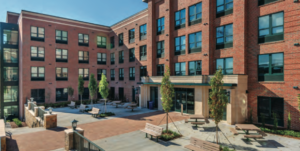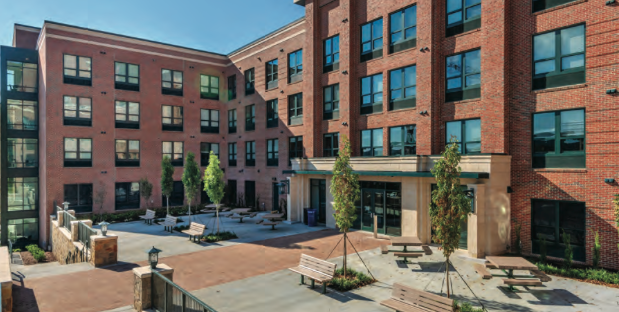
A new residence hall being completed at Appalachian State University this summer is the culmination of years of work and evidence of a commitment to sustainability that runs throughout the school’s culture.
School officials decided to certify the new residence hall through Green Built Alliance’s Green Built Homes certification system to ensure the project would be held to the highest sustainability standards.
“Sustainability is in our DNA,” said Lee Ball, chief sustainability officer at Appalachian State University. “Here at Appalachian State, sustainability is a tradition instead of a trend. The institution attracts faculty, students, and staff who care deeply about both people and places.”
The university began the planning process for this project in 2016 with Chancellor Sheri Everts’ vision to develop new residence halls and replace 1,700 on-campus beds in residence hall facilities which the university had been using for 50 to 70 years.
“Be assured these buildings are far more than brick and mortar,” said Everts. “They are homes for our students — places where they will make memories, build community and discover what it means to live and learn like a Mountaineer.”
The developer and contractor selection process began in fall 2017, the design process began in spring 2018, and construction began in spring 2019.
“Beyond the need for additional beds and parking, Chancellor Everts and her leadership team recognized the importance of modernizing our residence halls to meet the expectations of prospective students in the future, which included developing a cost-effective, sustainable project,” Associate Vice Chancellor for Student Affairs Matt Dull said.
App State partnered with RISE: A Real Estate Company to complete the multiphase, $191 million housing project to replace seven residence halls with the intent of making the new buildings highly efficient and sustainable. RISE and App State collaborated with Choate Construction on the project.
“Construction proved to be challenging and extremely rewarding for the Choate project team by overcoming unprecedented challenges presented by the COVID-19 pandemic,” Choate Project Manager Jay Merando said. “Unlike many projects where construction activities were suspended or timelines increased, this was not contemplated due to the fall semester move-in schedule. To overcome this, construction crews were spaced out through multiple shifts, weekend work and supplemental forces.”
According to the RISE website, the multiphase Public-Private Partnership development stands as a bold campus transformation. RISE is delivering more than 2,300 beds to the university all while maintaining housing capacity. Six old residence halls are being sequentially demolished and replaced, representing more than 600,000 square feet of new construction. Each phase is described below and despite the COVID-19 pandemic, the project timeline has remained intact.
Phase 1: During the initial phase, two residence halls —Thunder Hill Hall (Building 100) and Raven Rocks Hall (Building 200) — were developed and constructed on what had been the stadium parking lot, totaling 912 beds. Both opened for residents in August 2020. Also as part of the first phase, a parking deck with 477 spaces opened in August 2019 at the site of the former Winkler Hall, adding 250 more spaces to that area of campus. This phase also involved replacement of a steam line in the area.
Phase 2: Construction of Laurel Creek Hall (Building 300) began February 14, 2020. The building was dried in a year later. By June 2021, all apartments and corridors were completed and inspected, and the HVAC, sprinkler and elevator systems were operating. The building will open for students in August 2021 with approximately 640 beds.
Phase 3: As part of phase three, site work and the pouring of foundations and footers began in February 2021 for New River Hall (Building 400), which will have 750 beds. New River Hall replaces Justice Hall, which was demolished during summer to fall of 2020. Demolition of Gardner and Coltrane Halls will be completed in December 2021 and the area will become surface parking.
Since 2012, all newly constructed and renovated campus residence halls have been LEED certified. This project, however, deepened the commitment by certifying through Green Built Homes.
“Working with the Green Built Alliance offered us a level of partnership that allowed us to build upon and go beyond LEED standards. We chose to work with the Green Built Alliance and participate in their Green Built Homes certification program because they are a North Carolina-based accreditation program focused on working with the university throughout the project development and implementation,” Dull said. “Involving the team at Green Built Alliance in our early design reviews with the architect allowed us access to early-project actionable feedback for creating sustainable on-campus housing.”
The collaborative team is waiting on a few remaining pieces of information before submitting to Green Built Alliance for final review.
“In buildings such as the new App State dormitory buildings, a lot of those components are separated from one another — dorm rooms (sleeping areas), laundry areas, cooking facilities, lounge areas, et cetera,” said Matthew Vande of Vandemusser Design, who serves as the green rater on this project. “How the whole building is energy modeled becomes more complex, and how to quantify the greenness of various building strategies becomes a little more complicated.”
With sustainability at the core of the App State project, the collaborative team has included numerous green elements. Focus areas include the following.
Air sealing and insulation: Air-tightness testing was completed to ensure that in addition to the entire building being well sealed, the separations between each residence hall unit also provided a high level of air sealing and insulation to isolate sounds, odors and humidity.
Tree planting and repurposing: App State Grounds Department relocated the iconic gingko trees outside the project limits. For building 100, the team planted 39 new trees, and for building 200, they planted 25 trees. Additionally, 80 percent of the trees that had to be cleared from the site were taken to be milled and made into another usable product.
Resource efficiency: Low-flow and WaterSense-labeled plumbing fixtures were installed to reduce water usage and support water conservation. ENERGY STAR®-certified equipment was used for the shower and kitchen exhaust fans, dishwashers and apartment dryers. Energy-efficient refrigerators and appliances were installed. High-efficiency heating equipment was installed, and 75 percent of the buildings have ductless heating and cooling systems. LED lights were used throughout all buildings, and outdoor lighting controls are in place to automate usage.
Automated and innovative features: Both buildings have automated systems, which improve energy efficiency and lower operating and maintenance costs. They foster better indoor air quality as well as occupant comfort and productivity. The new buildings are connected to the App State steam plant via a newly installed underground high pressure steam line, which is used to generate domestic hot water through a Leslie heat exchanger to student units and laundry services. The steam also serves in the HVAC process by feeding the glycol loop to the rooftop air units.
Environmentally preferable materials: The team was intentional in using sustainable materials throughout all spaces. Independent certifying programs assured the materials were in compliance with stringent indoor air quality standards. Such materials included products that were GREENGUARD Gold certified and CARB II-compliant with no added formaldehyde, as well as low-VOC paints and coatings.
“For App State, the investment in these residence halls — and the other significant infrastructure projects initiated under Chancellor Everts’ leadership — represents our deep commitment to providing students an environment in which they can grow and flourish,” Ball said.
Susanna Shetley is a reporter at Smoky Mountain News, with which Green Built Alliance partners to publish its annual Green Building Directory.
You can also view this article as it was originally published on page 30 of the 2021-22 edition of the directory.


